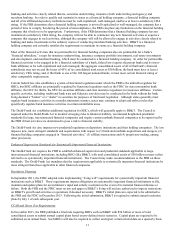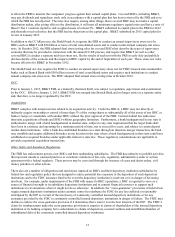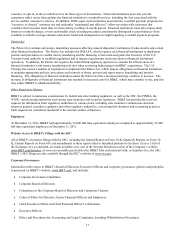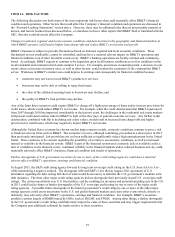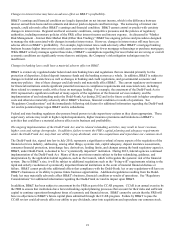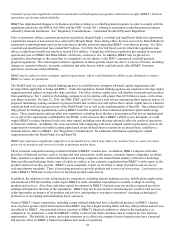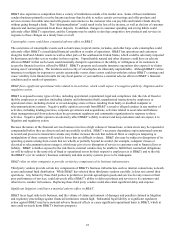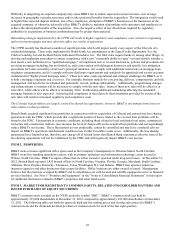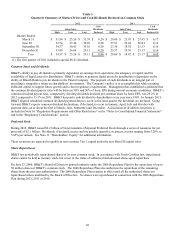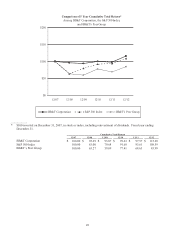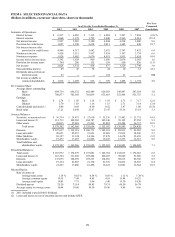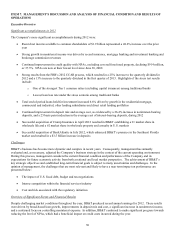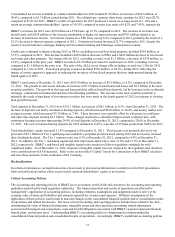BB&T 2012 Annual Report Download - page 43
Download and view the complete annual report
Please find page 43 of the 2012 BB&T annual report below. You can navigate through the pages in the report by either clicking on the pages listed below, or by using the keyword search tool below to find specific information within the annual report.21
Changes in interest rates may have an adverse effect on BB&T’s profitability.
BB&T’ s earnings and financial condition are largely dependent on net interest income, which is the difference between
interest earned from loans and investments and interest paid on deposits and borrowings. The narrowing of interest rate
spreads, could adversely affect BB&T’ s earnings and financial condition. BB&T cannot control or predict with certainty
changes in interest rates. Regional and local economic conditions, competitive pressures and the policies of regulatory
authorities, including monetary policies of the FRB, affect interest income and interest expense. As discussed in “Market
Risk Management – Interest Rate Market Risk (Other than Trading),” BB&T has ongoing policies and procedures designed
to manage the risks associated with changes in market interest rates. However, changes in interest rates still may have an
adverse effect on BB&T’ s profitability. For example, high interest rates could adversely affect BB&T’ s mortgage banking
business because higher interest rates could cause customers to apply for fewer mortgage refinancings or purchase mortgages.
While BB&T actively manages against these risks, if BB&T’ s assumptions regarding borrower behavior are wrong or overall
economic conditions are significantly worse than we anticipate, the Company’ s risk mitigation techniques may be
insufficient.
Changes in banking laws could have a material adverse effect on BB&T.
BB&T is extensively regulated under federal and state banking laws and regulations that are intended primarily for the
protection of depositors, federal deposit insurance funds and the banking system as a whole. In addition, BB&T is subject to
changes in federal and state laws as well as changes in banking and credit regulations, and governmental economic and
monetary policies. Any of these changes could adversely and materially affect BB&T. The current regulatory environment
for financial institutions entails significant potential increases in compliance requirements and associated costs, including
those related to consumer credit, with a focus on mortgage lending. For example, the enactment of the Dodd-Frank Act in
2010 represented a significant overhaul of many aspects of the regulation of the financial services industry, and the
implementation of and rulemaking under the Dodd-Frank Act during 2012 and in the future could result in higher compliance
costs and otherwise materially adversely affect BB&T’ s business, financial condition or results of operations. See
“Regulatory Considerations” and the immediately following risk factors for additional information regarding the Dodd-Frank
Act and its potential impact upon BB&T and its subsidiaries.
Federal and state banking regulators also possess broad powers to take supervisory actions as they deem appropriate. These
supervisory actions may result in higher capital requirements, higher insurance premiums and limitations on BB&T’ s
activities that could have a material adverse effect on its business and profitability.
The ongoing implementation of the Dodd-Frank Act, and its related rulemaking activities, may result in lower revenues,
higher costs and ratings downgrades. In addition, failure to meet the FRB’s capital planning and adequacy requirements
under the Dodd-Frank Act, may limit our ability to pay dividends, enter into acquisitions and repurchase our common stock.
The Dodd-Frank Act, signed into law in July 2010, represents a significant overhaul of many aspects of the regulation of the
financial services industry, addressing, among other things, systemic risk, capital adequacy, deposit insurance assessments,
consumer financial protection, interchange fees, derivatives, lending limits, and changes among the bank regulatory agencies.
BB&T, under Dodd-Frank, is deemed to be a “systemically important” institution. During 2012, federal agencies continued
implementation of the Dodd-Frank Act. Many of these provisions remain subject to further rulemaking, guidance, and
interpretation by the applicable federal regulators, such as the Council, which will regulate the systemic risk of the financial
system. Due to BB&T’ s size, it will be subject to additional regulations such as the “living will” requirements relating to the
rapid and orderly resolution of systemically important financial institutions in the event of material financial distress or
failure. BB&T cannot predict the additional effects that compliance with the Dodd-Frank Act or any regulations will have on
BB&T’ s businesses or its ability to pursue future business opportunities. Additional regulations resulting from the Dodd-
Frank Act may materially adversely affect BB&T’ s business, financial condition or results of operations. See “Regulatory
Considerations” for additional information regarding the Dodd-Frank Act and its impact upon BB&T.
In addition, BB&T has been subject to assessment by the FRB as part of the CCAR program. CCAR is an annual exercise by
the FRB to ensure that institutions have forward-looking capital planning processes that account for their risks and sufficient
capital to continue operations throughout times of economic and financial stress. BB&T cannot be certain that the FRB will
have no objections to BB&T’ s future capital plans submitted through the CCAR program. Failure by BB&T to pass the
CCAR review could adversely affect our ability to pay dividends, enter into acquisitions and repurchase our common stock.


